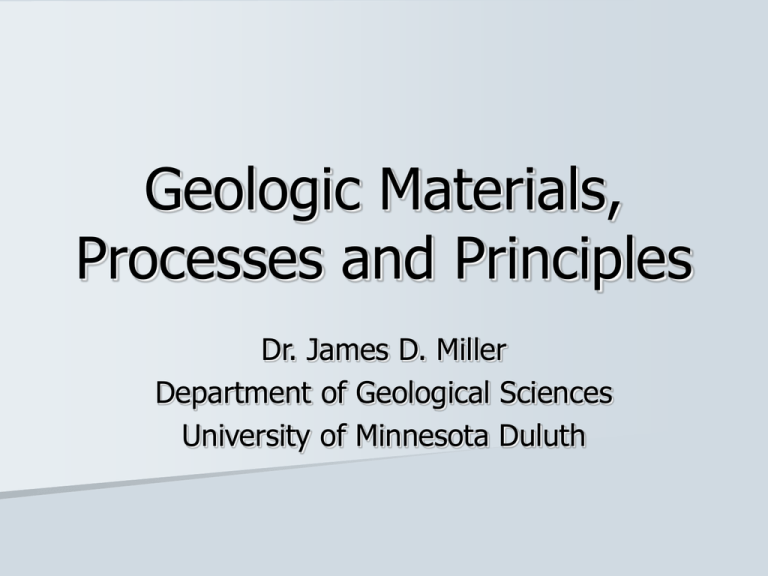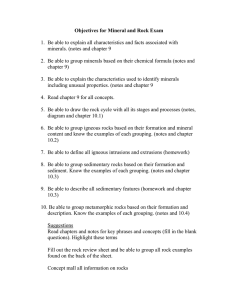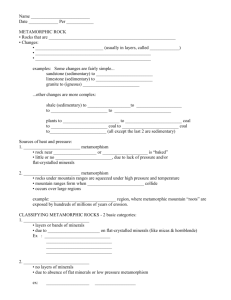Geologic Materials, Processes and Principles
advertisement

Geologic Materials, Processes and Principles Dr. James D. Miller Department of Geological Sciences University of Minnesota Duluth Geologic History of North America (incompletely) recorded in its rocks The Rock Cycle Showing the relationships between Earth Materials and Processes IGNEOUS ROCKS An aggregate of minerals crystallized from molten rock (magma) Generation of Magma Mafic – partial melting of the mantle Felsic – partial melting of the crust Igneous Environments Fine-grained = Volcanic Coarse-grained = Plutonic SEDIMENTARY ROCK Compacted and cemented accumulations of sediment, which can be of two general types - clastic and chemical Sedimentary Processes Weathering Mechanical Chemical Sedimentary Processes Erosion, Transport, and Deposition Sedimentary Processes Compaction and Cementation Criteria for Classifying Clastic Sedimentary Rocks Energy of Depositional System Types of Clastic Sedimentary Rocks & Environments of Formation MUDSTONE/SHALE - Well-sorted, mature, clay-sized particles ; generally implies deposition into quiet water SANDSTONE - Well-sorted, mature, commonly bedded, sand-sized particles typically transported by wind or moderate water movement (e.g. rivers, beaches) GREYWACKE - Moderately sorted, immature, clay- to sand-sized particles commonly showing graded bedding. Commonly deposited in deep waters off mountainous coasts CONGLOMERATE - Poorly sorted, immature, clay to boulder-sized particles transported only a short distance from their source and typically deposited by fast moving water. TILL - Very poorly sorted, clay to boulder-sized particles; non-bedded; deposited from glaciers. Environments of Clastic Sedimentation Chemical Sedimentary Rocks composed of minerals precipitated from water (usually ocean water) due to evaporation or to the activity of organisms IRON-FORMATION - Iron oxide minerals, usually magnetite (taconite ore) or hematite (natural ore), interlayered with chert (microcrystalline quartz) and clay minerals. Common chemical sedimentary rock biogenically formed in shallow marine environments older than about 1.8 billion years. LIMESTONE - Calcium carbonate (calcite) commonly containing abundant marine fossils. Most common type of chemical sediment forming today by biogenic processing of seawater. Dolomite (or dolostone) is created by replacement of calcium by magnesium after shallow burial of limestone. Forms in tropical shallow marine environments. EVAPORITE DEPOSITS (Gypsum, Halite, Anhydrite) – mineral precipitated from saline water in arid environments with high evaporation rates (e.g., playa lakes) PEAT/COAL – Carbonaceous material created by the accumulation, compaction and heating of organic matter. Forms in temperate to tropical, low energy, terrestrial environments (lagoons, floodplains). Environments of Chemical Sedimentation Evaporites Coal Limestone Metamorphic Rocks Metamorphism- changes in the mineral assemblage and textures of igneous, sedimentary or other metamorphic rocks due to prolonged exposure to elevated temperatures and pressures (or increased grades of metamorphism) Controls on Rates of Metamorphic Change Fluid content (particularly water) of the rock. Water helps to catalyze the mineral transformations. Water gets “baked” out of rocks during prograde metamorphism. Temperature - chemical reactions occur faster at higher temperatures. Time - For a rock to develop a new metamorphic mineral assemblage corresponding to a particular P & T, it must exist under those condition for a sufficiently long period of time (generally tens of thousands to millions of years). Mineralogic Response to Metamorphism Minerals that form depend on: T and P conditions Bulk composition of the source rock Progressive metamorphism of a graywacke (dirty sandstone) Textural Response to Metamorphism Reflects the intensity and directionality of pressure (or stress). Increased grain size - During prograde metamorphism or at a particular grade that is maintained for a long period of time, minerals will tend to increase in size. Foliation - As new platy minerals grow, they will align themselves perpendicular to the maximum stress direction. For clay mineral and fine-grained micas, the planar fabric that results is referred to as a slaty cleavage. In higher grade rocks, coarser grained mica minerals are said to impart a schistosity to the rock. Gneissic Banding - In very high grade rocks, the dark minerals tend to segregate from the lighter colored minerals (feldspar and quartz) resulting in banded rock. What Drives the Rock Cycle? Plate Tectonic Theory The Earth’s outer shell (lithosphere) is composed of rigid plates that are moving relative to one another OROGENESIS Culmination of Plate Convergence Continental Rifting The creation of new ocean basins Relative Time Superposition Faunal Succession Geologic Time Absolute Time Radiometric Dating Cross-cutting Relationships Unconformities Gaps in the Geological Record Siccar Point, Scotland The Rock Cycle Recorded in the Lake Superior Region





